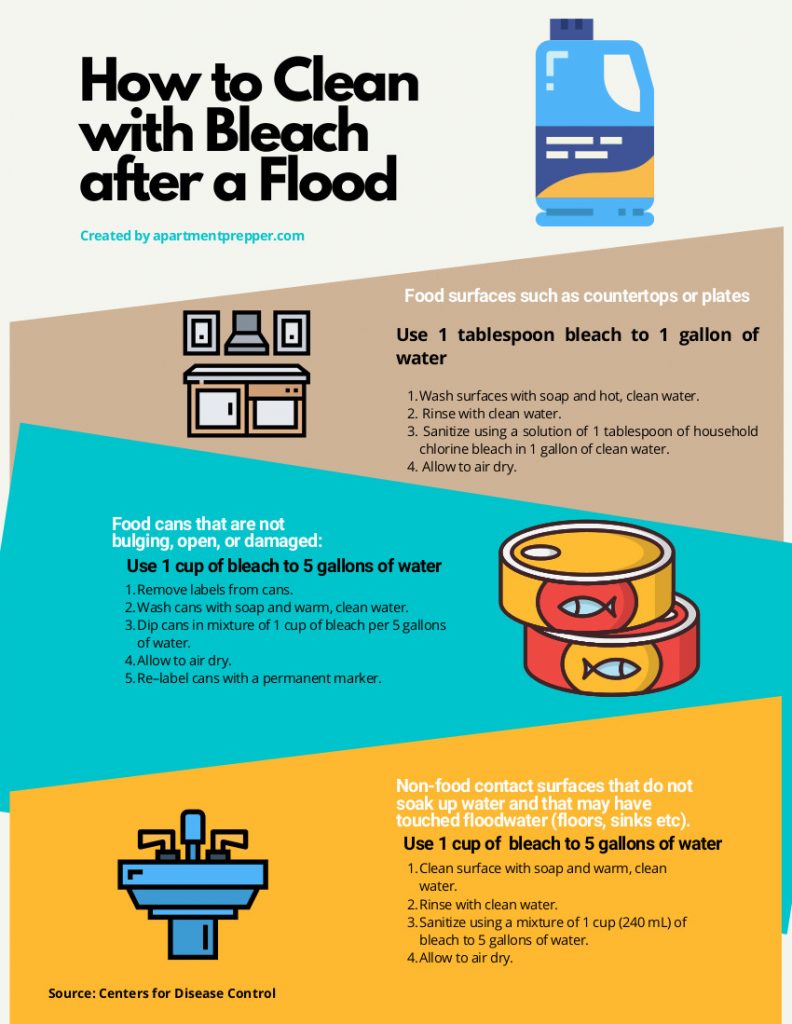This post is by Bernie Carr, apartmentprepper.com
Plain bleach is one of those products that is often recommended we keep in our emergency kit. Why? Because bleach is useful for disinfecting and cleaning. But bleach can be a dangerous chemical if not used or handled correctly. It’s a good idea to know how to use it in advance in case an emergency happens. When you are in a high stress situation, it’s difficult enough to stay calm, let alone trying to remember what is the correct way to do things such as purify water or sanitize your surroundings.
Precautions
Before we begin, let’s remember these precautions so no one gets hurt in the process.
· Never mix bleach and ammonia OR any other cleaning products such as vinegar or alcohol. Before you wonder if this is actually that lethal, there are cases of deaths occurring from mixing bleach and other cleaners, such as one that happened in 2019. A restaurant manager in Massachusetts died when he tried cleaning off bleach that was spilled on a floor cleaned with another cleaning product. In other reported cases, people got very sick and required long hospitalizations.
· Wear protective gloves if you are handling bleach. Use eye protection as well.
· Use bleach in a well-ventilated area. Open a window or door to make sure you have fresh air around you.
Let’s look at some of the emergency uses for bleach and the proper way to use it.
Water Purification
There are several ways to purify drinking water, and using chlorine bleach is one of them.
What type of bleach should you use to purify water?
Use plain unscented chlorine household bleach (5.25% to 5% concentration of sodium hypochlorite) to purify water. Some brands of bleach that are concentrated (generally shows “ultra” on the label) are not appropriate for disinfecting water.
You will also need a dropper.
Proportion of bleach to water
The rule is two drops of bleach to a quart of water. Or, if you have more water, use eight drops of bleach or 1/8 teaspoon, per gallon of water. Mix well then allow the water to stand for 30 minutes.
If the water is very cloudy, you may double the amounts listed above, and let stand for 30 minutes.
What if you don’t have a medicine dropper?
Take an inch sized paper towel, toilet paper or cloth, and a small cap of bleach you can make a dropper.
Drop some bleach on the cap. Allow the piece of paper to hang off the side of the cap and tilt slightly so the paper is touching the bleach. The paper will act like a wick and the bleach will slowly drip off the paper in small drops.
Cleaning and sanitizing household items after a flood
After Hurricane Harvey hit Houston a couple of years ago, there were a lot of homes that were damaged by flood waters. Flood waters are toxic mix of gasoline, oil, sewage, fertilizer and other chemicals. Even if the home was not badly damaged, exposure to flood waters requires disinfecting.
The infographic below will provide the correct proportions of bleach to water, as well as instructions on how to clean with bleach:

How long does chlorine bleach last?
Plain household bleach, when properly stored generally expires within a year and its effectiveness will diminish.
Store bleach in a cool, dry place, and away from direct sunlight. All of these factors will affect the quality and shelf life of bleach. The ideal temperature is around 50-70 degrees.
If you store a few bottles of bleach, mark the expiration date using a permanent marker. As with other supplies, use the “first in, first out” method of inventory: always use the oldest item first. Make sure you routinely rotate your supplies so you never run out.
**********************************************************************
We are an affiliate of Amazon.com, which means we received a small commission if you click through one of our Amazon links when you shop, at totally no cost to you. This helps keep the lights on at the blog. Thanks!
About the author:
Bernie Carr is the founder of Apartment Prepper. She has written several books including the best-selling Prepper’s Pocket Guide, Jake and Miller’s Big Adventure, The Penny-Pinching Prepper and How to Prepare for Most Emergencies on a $50 a Month Budget. Her work appears in sites such as the Allstate Blog and Clark.com, as well as print magazines such as Backwoods Survival Guide and Prepper Survival Guide. She has been featured in national publications such as Fox Business and Popular Mechanics. Learn more about Bernie here.


